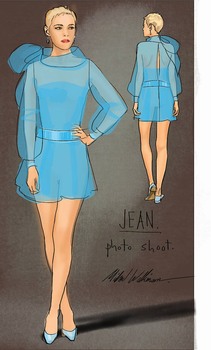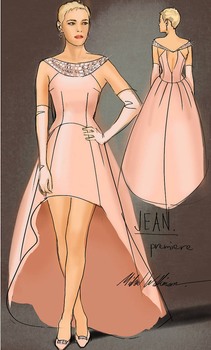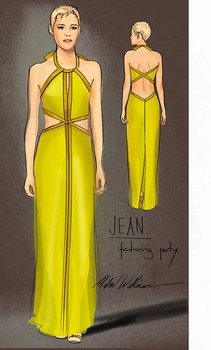Click on image for full view.
Googled translated.
Mr. Wilkinson, how did you go about helping Kristen Stewart transform into Nouvelle Vague star and It Girl Jean Seberg?
Kristen and I were deeply moved by Jean Seberg's story. You can study human strengths and weaknesses on her, for us she was the intense discovery of a psychologically highly complex person. For me, designing costumes for people who are full of contradictions and small flaws is especially grateful. Kristen works harder than almost any other actress I've met and she is very intuitive at work. We had long discussions about what which costume should express, it was a great collaboration. It quickly became clear that Kristen had no ego problems when it came to the costumes. For both of us, it was primarily about finding clothes that fit the scene and are not just “fashion-conscious”.
Then where did you get the inspiration for the final designs?
Jean and Kristen were my inspiration for the costume design. I was fascinated by the parallels between these two women. Both are icons, both are uncompromising and completely modern. You have great self-confidence. I wanted to incorporate that into the film and express that strength with the costumes.
How would you describe the style of the two?
Kristen and Jean have a very modern style that doesn't seem effortless or ornate. You feel comfortable in very expensive designer clothes as well as in the simplest casual look. You never get the impression that a dress overwhelms or covers the person. The individual personality always shines through. I think that has a lot to do with the energy created by the contrasts: the short hair goes with feminine couture as well as a surprising personal touch, such as wearing casual clothes whose cut is based on men's fashion. Both women have a personal strength that makes the clothes they wear seductive.
Have you studied a lot of historical material beforehand?
I saw all of Jean Seberg's films so that I could “get to know” them. I wanted to understand their on-screen magic. Then I did extensive research on the period from 1968 to 1970 in which our film was set. I studied all the clothes Jean actually wore at the time, looked at her personal photos, film photos from the studios, paparazzi and fashion photos as well as magazine articles. Some of the costumes in the film are directly inspired by these images. To get the right clothes for those private moments about which there were no photo documents, I had to put myself in Jean's head and imagine what she would have chosen for them. When it comes to jeans style, most people think of the pictures of you as a world-famous it girl, i.e. the time when when she was "discovered" by Otto Preminger and played "Saint Joan" in 1957 and then appeared in Godard's "Breathless" in 1960. Back then, she sported this light, modern and idiosyncratic wardrobe: a few staples that got a personal touch with her rasped pixie haircut, which she paired with a flawless white shirt, capri pants, ballet shoes and the famous striped Breton T-shirt combined.
A look that doesn't even appear in the film ...
In the film, Jean's celebrity is almost over and her film career is starting to stagnate, she is no longer the carefree ingenious trendsetter, she has gotten older and also more insecure. I've talked about their classic casual style in a few scenes, but we mostly see them differently. We see her in her house, vulnerable and relaxed in sheer, delicate underwear and silk dressing gowns. We see her at her public appearances when she wears designer labels like armor in which she can face the world. The style of this time is very plastic and strong - Jean Seberg wore dresses from all the big houses from Yves Saint Laurent, Courrèges, Chloé to Givenchy.
Do you have a favorite outfit?
I wanted Kristen to get the glow from Jean, her indestructible spirit, that light she was giving off from within - so in some scenes I put her in bold yellow, pure blue, red and white, or chartreuse green. But I also wanted to get the paranoia across. So in some scenes she wears colors that make her pale. Director Benedict Andrews said he would like to show her as pale as a fragile orchid. After her miscarriage, she had the darkest moment of her life from which she never fully recovered, so I let her wear black. But one of my favorite costumes is the red leather jacket that I chose to reflect her passion for life and her impetuous esprit.
How did you actually start with costume design?
As a teenager, I made some money dressing up at operas, ballet, and theaters. This world “behind the scenes” captured me and I discovered my “tribe” there, people who tick just like me. That's when I knew I wanted to work through the costumes in this rich world of storytelling. I studied costume design and learned everything from pattern making to art and film history, costume making and illustration. After graduating, I started designing for small theater companies. Then came bigger orders and at some point finally the first small independent films. I moved to America and worked there for 15 years before returning to London five years ago.
And what was the most difficult project you have worked on so far?
"Aladdin" (editor's note: Disney's live film 2019) was incredibly ambitious. The task consisted of dazzling the senses with a wealth of colors and creating a world of its own that still seemed so grounded and authentic that the audience could emotionally follow. Another big challenge was “American Hustle” because it was such an organic way of filming. Director David O. Russell kept us busy with new developments in the story. It was very exciting to work so raw and energetic.
Many of your designs appear very flamboyant and impress with their remarkable feel, which is also transferred to the canvas.
I love it when a film inspires me, so I try to inspire audiences with my work too. For "Jean Seberg" I went over with director Andrews what each costume was supposed to express, discussed it all again with Kristen, and then I withdrew and designed every single detail. Because the colors, cuts and textures were so specific, I had most of the costumes made directly by a great team of tailors in Los Angeles. I looked for the fabrics and trimmings at vintage fabric collectors and in special fabric shops in Los Angeles. I sourced a few of the costumes and all of the accessories from my favorite costumes distributors on the West and East Coasts and from vintage dealers around the world.
Sometimes this is reminiscent of the costumes of classic old Hollywood. Do you have a favorite era that keeps inspiring you?
I have a very eclectic style, I love Elizabethan textiles, 3D printing, mid-century furniture, Japanese cinema of the fifties and the music of the 18th century. There is good - and bad - design in every era. But my main inspirations are colors. I draw joy and strength from those who surround me every day.
Source





No comments:
Post a Comment
What do you think of this?